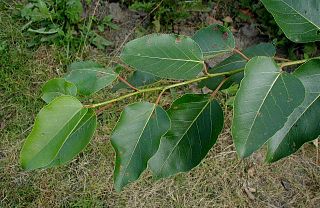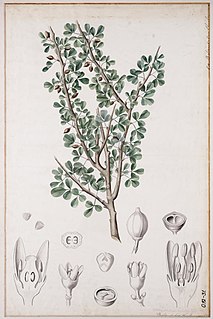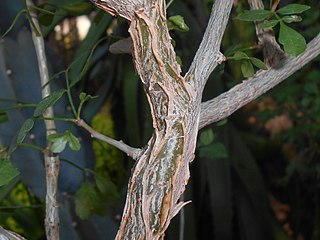
In polymer chemistry and materials science, resin is a solid or highly viscous substance of plant or synthetic origin that is typically convertible into polymers. Resins are usually mixtures of organic compounds. This article focuses on naturally occurring resins.

Myrrh is a natural gum or resin extracted from a number of small, thorny tree species of the genus Commiphora. Myrrh resin has been used throughout history as a perfume, incense, and medicine. Myrrh mixed with wine can also be ingested.

Populus section Aigeiros is a section of three species in the genus Populus, the poplars. Like some other species in the genus Populus, they are commonly known as cottonwoods. The species are native to North America, Europe, and western Asia. In the past, as many as six species were recognized, but recent trends have been to accept just three species, treating the others as subspecies of P. deltoides.

Balsam is the resinous exudate which forms on certain kinds of trees and shrubs. Balsam owes its name to the biblical Balm of Gilead.
Canada balsam, also called Canada turpentine or balsam of fir, is a turpentine made from the resin of the balsam fir tree of boreal North America. The resin, dissolved in essential oils, is a viscous, sticky, colourless or yellowish liquid that turns to a transparent yellowish mass when the essential oils have been allowed to evaporate.

The balsam poplars are a group of about 10 species of poplars, indigenous to North America and eastern Asia, distinguished by the balsam scent of their buds, the whitish undersides of their leaves, and the leaf petiole being round in cross-section. They are large deciduous trees, 30–60 m tall, with leaves with a rounded base, pointed apex, and a whitish waxy coating on the underside of the leaf; this latter distinguishes them from most other poplars. The name is derived from the pleasant balsam smell of the opening buds and leaves in spring, produced by a sticky gum on the buds which also helps protect the buds from insect damage. The balsam poplars are light-demanding trees that require considerable moisture. Poplars are tolerant of very cold conditions, occurring further north than other poplars except for the aspens. The poplars in Southern California are tolerant of 100 plus degree heat. They grow along dry washes and dry riverbed‘s. The dry washes and dry riverbeds will have flowing water when it rains sufficiently. Their leaves hang down and are at an edge to the sun. This may be another factor why they can take the high heat. Their leaves tremble in the slightest breeze like the quaking aspen

The Burseraceae are a moderate-sized family of 17-19 genera and about 540 species of flowering plants. The actual numbers differ according to the time period in which a given source is written describing this family. The Burseraceae are also known as the torchwood family, the frankincense and myrrh family, or simply the incense tree family. The family includes both trees and shrubs, and is native to tropical regions of Africa, Asia, and the Americas.

Storax, often commercially sold as styrax, is a natural resin isolated from the wounded bark of Liquidambar orientalis Mill. and Liquidambar styraciflua L. (Hamamelidaceae). It is distinct from benzoin, a similar resin obtained from the Styracaceae plant family.

Balm of Gilead was a rare perfume used medicinally, that was mentioned in the Bible, and named for the region of Gilead, where it was produced. The expression stems from William Tyndale's language in the King James Bible of 1611, and has come to signify a universal cure in figurative speech. The tree or shrub producing the balm is commonly identified as Commiphora gileadensis. Some botanical scholars have concluded that the actual source was a terebinth tree in the genus Pistacia.

The genus of the myrrhs, Commiphora, is the most species-rich genus of flowering plants in the frankincense and myrrh family, Burseraceae. The genus contains approximately 190 species of shrubs and trees, which are distributed throughout the (sub-) tropical regions of Africa, the western Indian Ocean islands, the Arabian Peninsula, India, and Vietnam. The genus is drought-tolerant and common throughout the xerophytic scrub, seasonally dry tropical forests, and woodlands of these regions.

Commiphora gileadensis, the Arabian balsam tree, is a shrub species in the genus Commiphora growing in Saudi Arabia, Yemen, southern Oman, Sudan and in southeast Egypt where it may have been introduced. Other common names for the plant include balm of Gilead and Mecca myrrh, but this is due to historical confusion between several plants and the historically important expensive perfumes and drugs obtained from them. True balm of Gilead was very rare, and appears to have been produced from the unrelated tree Pistacia lentiscus. This species also used to include Commiphora foliacea however it was identified and described as a separate species

Populus balsamifera, commonly called balsam poplar, bam, bamtree, eastern balsam-poplar, hackmatack, tacamahac poplar, tacamahaca, is a tree species in the balsam poplar species group in the poplar genus, Populus. The genus name Populus is from the Latin for poplar, and the specific epithet balsamifera from Latin for "balsam-bearing".
"There Is A Balm in Gilead" is a traditional African American spiritual.

Amyris is a genus of flowering plants in the citrus family, Rutaceae. The generic name is derived from the Greek word αμυρων (amyron), which means "intensely scented" and refers to the strong odor of the resin. Members of the genus are commonly known as Torchwoods because of their highly flammable wood.

Stacte and nataph are names used for one component of the Solomon's Temple incense, the Ketoret, specified in Exodus 30:34. Variously translated to the Greek term or to an unspecified "gum resin" or similar, it was to be mixed in equal parts with onycha, galbanum and mixed with pure frankincense and they were to "beat some of it very small" for burning on the altar of the tabernacle.
Balsam tree is the common name given to several genera or species of trees that are the source of resinous products, often known as balsam or balm.
Balsam is a group of plant products derived from various plants. Balsam may also refer to:

Commiphora habessinica, sometimes known as Abyssinian myrrh or the Yemen myrrh, is a plant native to northeast Africa and the Arabian peninsula, including Djibouti, Eritrea, Ethiopia, Zambia, Malawi, Oman and Yemen. It was first described by Otto Karl Berg in 1862 as Balsamodendrum habessinicum from northeast Africa. It was then transferred to the genus Commiphora by Adolf Engler in 1883, but given the name Commiphora abyssinica, an orthographical variant. It can be recognised by its simple, serrate leaves and by the pseudo aril, covering the seed, which has four almost linear arm-like lobes.
Populus × jackii is the hybrid between balsam poplar, Populus balsamifera, and the eastern cottonwood, Populus deltoides, occurring occasionally where the two parental species' ranges overlap. It is sometimes called a cottonwood. This hybrid is also sometimes planted as a shade tree, and occasionally escapes from cultivation. This hybrid is also known by the synonyms Populus × andrewsii Sargent, P. × bernardii Boivin, Populus candicans W. Aiton, P. × dutillyi Lepage, P. × generosa Henry, P. × gileadensis Rouleau, and P. manitobensis Dode.













